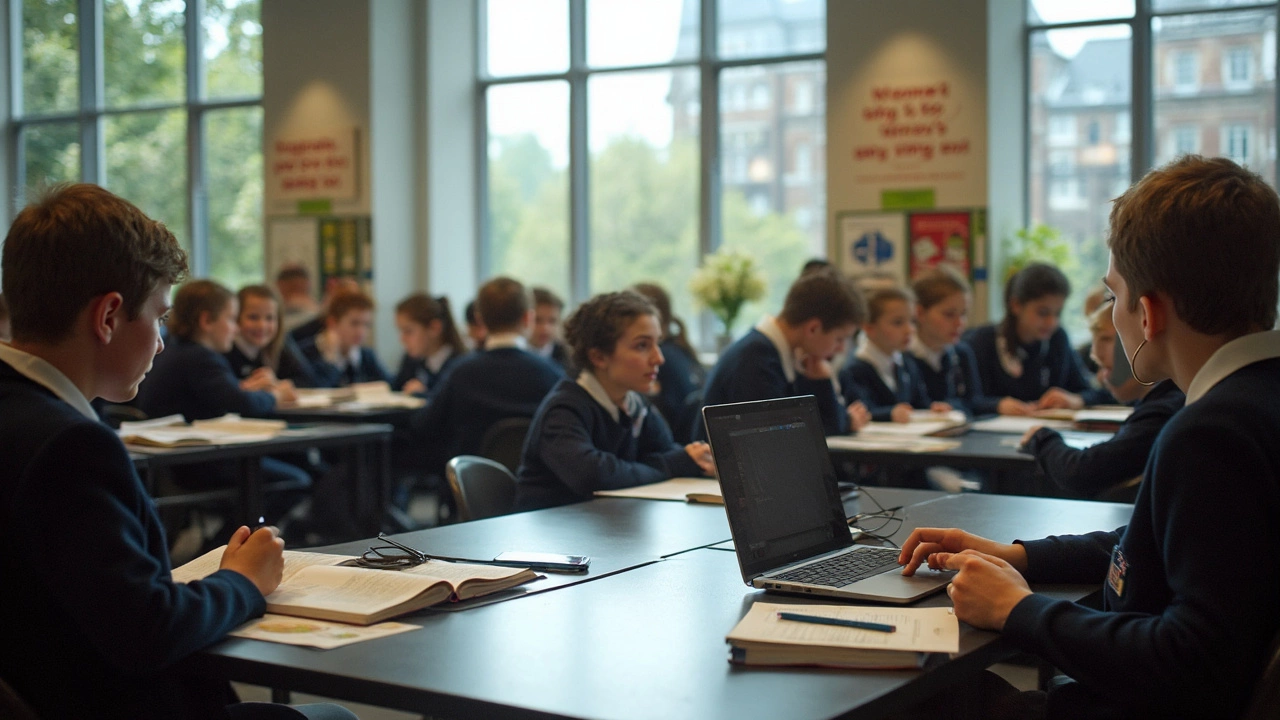Your GCSE exam prep doesn’t just tire your brain—it can wear out your eyes, too. Hours staring at revision notes and screens brings on headaches, blurry vision, and that gritty, tired feeling no one enjoys. But there’s a clever trick you probably haven’t tried yet: the 20 20 20 rule.
Every 20 minutes, look at something 20 feet away for 20 seconds. That’s it. Super simple, but it interrupts the tunnel vision that creeps in when you’ve been staring at the same screen or page for ages. Your eyes get a chance to refocus so you can keep working without feeling wiped out.
Loads of optometrists recommend this rule. It’s not just for nerdy eye doctors—pro gamers and tech workers swear by it to stay alert and comfortable for hours. If you’re tackling a full day of revision, this little hack beats powering through until your vision goes fuzzy.
- What Is the 20 20 20 Rule?
- Why Eye Strain Is a Real Problem for GCSE Students
- How to Add the 20 20 20 Rule to Your Revision Routine
- Extra Revision Tips That Keep Your Mind and Eyes Sharp
What Is the 20 20 20 Rule?
The 20 20 20 rule is basically a quick system for giving your eyes a break during serious study sessions. It was created by eye experts as a solution for digital eye strain, which you get from staring at screens or books for too long. Here’s the deal: every 20 minutes, you pause your work and look at something around 20 feet away for at least 20 seconds. That’s it—no special tools or fancy gear needed.
This rule isn’t just a random tip. It’s based on how your eyes work. When you focus close-up for ages—like scrolling through phone notes or revising loads of flashcards—your eye muscles get tired. Giving them a short break to focus far away lets those muscles relax. It’s like stretching your legs in-between sprints.
You might think a quick glance away is pointless, but studies from places like the American Optometric Association show this can seriously cut down on headaches, blurry vision, and dry or sore eyes. It helps keep you locked in on revision instead of battling to stay comfortable.
Here’s exactly how to use the 20 20 20 rule during your GCSE revision:
- Set a timer on your phone for 20-minute intervals while you study.
- When the timer goes off, drop your pen (or mouse), and look at something at least 20 feet (around 6 meters) away. If you’re inside, that could be out a window or across the room.
- Keep looking for 20 seconds. It’s actually longer than it seems—count out loud if it helps.
- Jump back into your work.
It might sound like a small thing, but over a two-hour GCSE revision session, you’ll give your eyes multiple proper rests. That can make a difference, especially during those crunch weeks leading up to exams.
Why Eye Strain Is a Real Problem for GCSE Students
Here’s a fact you can’t ignore: the average GCSE student spends more than 5 hours a day looking at screens or books during revision season. That’s a lot of work for your eyes. Most people don’t even realize how much time they’re glued to their devices until the headaches, dry eyes, and blurry vision kick in. This is classic eye strain.
When you focus on screens, you blink less than half as much as normal. Blinking keeps your eyes fresh by spreading tears across your eyeballs, but once you start studying hard, your blink rate drops. That’s when your eyes dry out and you get the ‘sandpaper’ feeling that can really distract you from your GCSE revision.
- Eye strain makes it harder to concentrate and remember facts.
- You’ll get tired quicker and start skimming instead of understanding the material.
- Eye strain can cause regular headaches, even after short study sessions.
According to a 2023 survey by the Association of Optometrists, 70% of UK students reported eye discomfort during exam revision. That’s not minor. Here’s a quick snapshot:
| Symptom | Percent of Students Affected |
|---|---|
| Eye fatigue | 65% |
| Headaches | 52% |
| Dry eyes | 49% |
Ignoring eye strain means you’re working against yourself. Rather than toughing it out, using strategies like the 20 20 20 rule gives you a real edge. It’s about working smarter and making sure your study habits don’t mess with exam performance—or your health.

How to Add the 20 20 20 Rule to Your Revision Routine
Making the 20 20 20 rule part of your GCSE revision is easy, and it doesn't mess up your focus—it actually helps. If you use a timer on your phone, smartwatch, or even an old-school kitchen timer, you can remind yourself to take breaks without having to think about it between flashcards and practice papers.
Here’s how most students get started:
- Set your timer for 20 minutes at the start of a study session.
- When the timer goes off, look away from your book or screen and pick a spot at least 20 feet away—like a window, a poster, or something across the room.
- Focus on that spot for 20 seconds. This short pause gives your eyes a mini reset.
- Repeat during every revision block. If you use the Pomodoro Technique (25 minutes on, 5 off), just tweak it—pause at the 20-minute mark for your eyes and keep the longer break after 25 minutes.
If you’re using a study app or revision planner, look for a setting to add custom reminders. Some students stick a bright post-it on their desk as a visual cue. Anything that helps you remember works—just don’t trust yourself to remember it without a nudge!
And here’s an eye-opener: According to a survey by the College of Optometrists in 2023, over 60% of students using the 20 20 20 rule reported fewer headaches and less eye strain during exams. It’s not magic, just a smart move for anyone prepping for a ton of subjects.
Keep some water nearby, too. Hydration helps you focus, and dry eyes often feel worse when you’re dehydrated after hours of study. If you wear glasses or contacts, you’re even more likely to feel the benefits from regular eye breaks.
Slide this rule into your routine, along with your other study tips and exam preparation tricks. It’s low-effort, but the payoff is huge—sharper focus, less eye pain, and better revision results.
Extra Revision Tips That Keep Your Mind and Eyes Sharp
Sticking to the 20 20 20 rule is a strong start, but you can level up your GCSE revision game by mixing in a few more smart habits. Let's talk about real, practical stuff that helps you keep boosting your grades and looking after your eyes at the same time.
- Switch up your revision methods. Instead of staring at a screen for hours, try hand-written flashcards, voice notes, or even whiteboards. Switching devices gives your eyes and brain something new to focus on.
- Use proper lighting. Revision is way easier when you’re not squinting or dealing with glare. Try to face a window, or use a desk lamp with a soft, even light. According to the National Eye Institute, bad lighting increases eye strain and tiredness.
- Stay hydrated. Drinking enough water isn't just for athletes—it keeps your eyes from drying out too. Aim for a glass every hour, especially during long revision sessions. Dehydration is linked to headaches and fatigue, which you want to avoid.
- Stand up and stretch every half hour. Get your blood moving and give your whole body (not just your eyes) a quick reset. Even just touching your toes or reaching up can help wake you up.
- Break big tasks into mini-sessions. Use the Pomodoro technique: 25 minutes of focus, then a 5-minute break. Combine this with the 20 20 20 rule and you've got a killer combo for keeping both your mind and vision fresh.
- Eat snacks that help your brain and eyes. Nuts, blueberries, carrots, and eggs are loaded with vitamins that support memory and focus. A 2021 study from the University of Reading found that eating berries boosted students’ attention during afternoon study blocks.
| Habit | How It Helps |
|---|---|
| 20 20 20 Rule | Prevents eye strain, helps focus |
| Pomodoro Technique | Stops burnout, keeps revision interesting |
| Proper lighting | Lowers headaches, improves reading |
| Hydration | Reduces fatigue, keeps eyes moist |
| Healthy snacks | Boosts brain power and concentration |
Stacking these tips with your regular revision routine can make prep feel less like a slog. Your mind stays sharp, your eyes stay comfortable, and you’re more likely to actually remember what you read when exam day rolls around.
